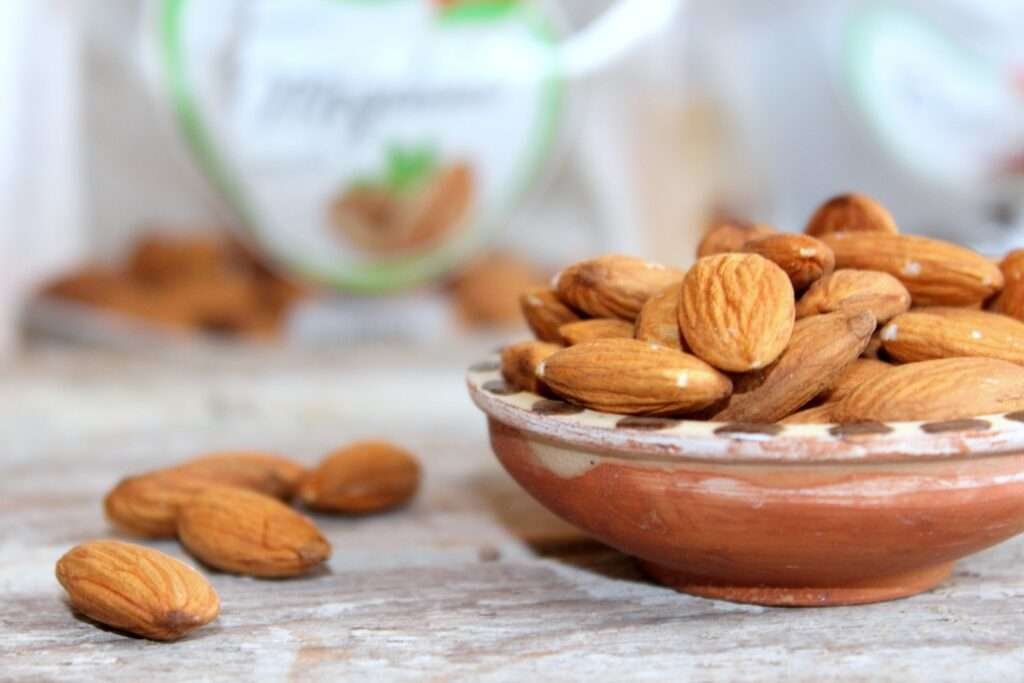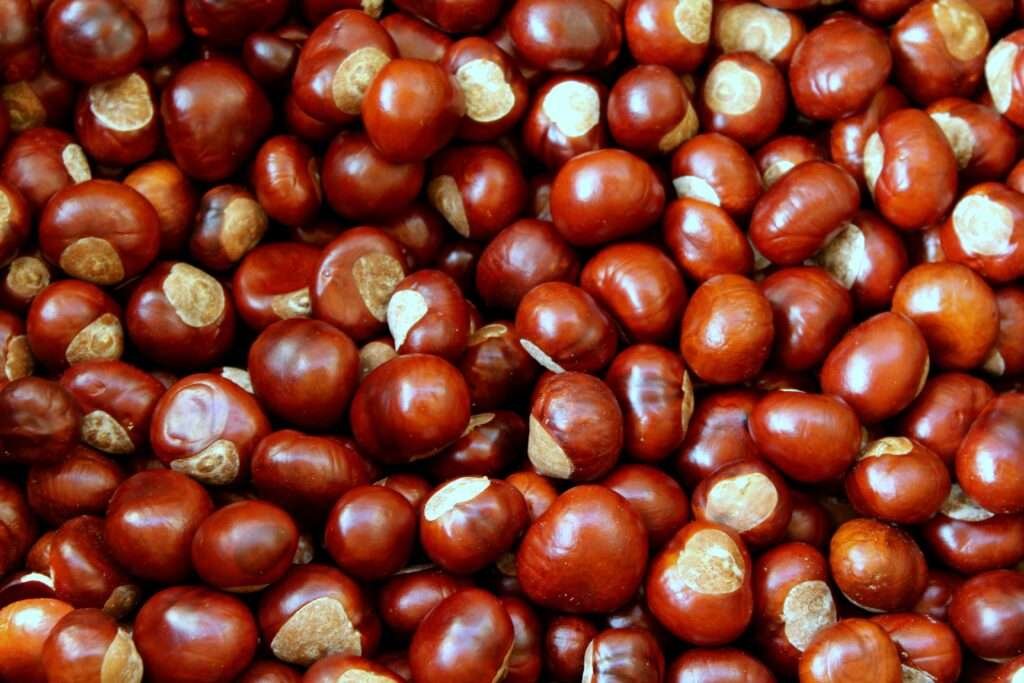Nuts are nature’s bite-sized nutritional powerhouses, packed with essential nutrients, healthy fats, and protein. They come in various shapes, sizes, and flavors, offering a diverse range of health benefits. Let’s crack open the shell and delve into the world of nuts to explore their health benefits and culinary versatility.
1. Almonds
Almonds are pretty versatile! They’re not only tasty but also packed with nutrients like healthy fats, protein, fiber, vitamins, and minerals. Plus, they make a great snack on their own, but they’re also used in many recipes, from savory dishes to desserts. And let’s not forget almond milk, almond flour, and almond butter, which have become popular alternatives for those with dietary preferences or restrictions.

- Origin: China and Central Asia
- Calories: 173 cal per 30g
- Vitamin E
- Minerals: Calcium, Phosphorus, Magnesium
2. Cashews
Cashews are another delicious and nutritious nut! They’re rich in healthy fats, protein, vitamins, and minerals, including copper, magnesium, and zinc. Cashews have a creamy texture and a slightly sweet flavor, making them a popular ingredient in both savory and sweet dishes.
- Origin: northeastern Brazil
- Calories: 166 cal per 30g
- Vitamin K
- Minerals: Protein, Calcium, Phosphorous, Magnesium
3. Pistachios
Pistachios are not only delicious but also quite nutritious! These nuts have a unique flavor—slightly sweet with a hint of earthiness—and a vibrant green color. They’re often enjoyed as a snack on their own, either in their shell or shelled, but they’re also used in various culinary applications.

- Origin: Iran, Iraq, and Syria
- Calories: 169 cal per 30g
- Vitamin: B6, A, E, K and C
- Minerals: Potassium, Phosphorus, Magnesium, Calcium
4. Brazil Nuts
Brazil nuts are unique among nuts due to their large size and distinct flavor. These nuts have a rich, creamy texture and a slightly sweet taste with a hint of bitterness. They’re often enjoyed as a snack on their own, but they can also be chopped and added to salads, granola, or baked goods for an extra crunch and flavor. Additionally, Brazil nut milk can be made as a dairy-free alternative to cow’s milk.

- Origin: Peru, Bolivia and Brazil
- Calories: 197 cal per 30g
- Vitamin E
- Minerals: magnesium, copper, and zinc
5. Macadamia nuts
Macadamia nuts are known for their rich, buttery flavor and creamy texture, making them a favorite among nut enthusiasts. These nuts are not only delicious but also packed with nutrients.

- Origin: Australia
- Calories: 215 cal per 30g
- Vitamin: B1, B6 and E
- Minerals: Magnesium, Calcium, Potassium, Phosphorus, Iron
6. Pecans
Pecans are beloved for their rich, buttery flavor and crunchy texture, making them a popular nut for both snacking and cooking.

- Origin: central and eastern North America and the river valleys of Mexico
- Calories: 207 cal per 30g
- Vitamin: A and E
- Minerals: Folic Acid, Calcium, Magnesium, Phosphorus, Potassium and Zinc
7. Peanuts
Peanuts are actually legumes rather than true nuts, but they’re often grouped with nuts due to their similar taste, nutritional profile, and culinary uses. They’re widely loved for their savory flavor and crunchy texture.

- Origin: Peru or Brazil in South America
- Calories: 170 cal per 30g
- Vitamin E
- Minerals: iron, zinc, potassium and magnesium, antioxidant minerals (selenium, manganese and copper)
8. Walnuts
Walnuts are known for their distinct flavor, crunchy texture, and numerous health benefits. Its cerebral cortex is covered in folds, and the entire brain is contained within a protective covering, called the skull. Similarly, a walnut can be divided into two halves. The nut itself is covered in wrinkle-like folds and encased in a hard shell, much like the human skull.

- Origin: Central Asia
- Calories: 196 cal per 30g
- Vitamin: E and B6
- Minerals: Copper, Folic Acid, Phosphorus and Manganese
9. Hazelnuts
Hazelnuts, also known as filberts or cobnuts, are delicious nuts with a slightly sweet flavor and a creamy texture. They are packed with nutrients, including healthy fats, protein, fiber, vitamins, and minerals.

- Origin: China in 2838 BC
- Calories: 188 cal per 30g
- Vitamin E and B6
- Minerals: Magnesium, Copper, Manganese and Phosphorus.
10. Pine nuts
Pine nuts are the edible seeds of pine trees and are known for their delicate flavor and creamy texture. They’re commonly used in cooking, particularly in Mediterranean and Middle Eastern cuisines, where they add a rich nutty taste to a variety of dishes.

- Origin: Mediterranean, North America, and Asia
- Calories: 202 cal per 30g
- Vitamin: E and K
- Minerals: magnesium, iron, antioxidants, zinc, and protein
11. Chestnuts
Chestnuts are unique among nuts because they have a starchy, rather than oily, texture. They’re rich in complex carbohydrates, making them more similar to grains like rice or potatoes than to other nuts.

- Origin: Asia
- Calories: 39 cal per 30g
- Vitamin: B6, C
- Minerals: Copper, Manganese, Thiamine, Riboflavin, and Potassium
12. Tiger nuts
.

- Origin: Ancient Egypt
- Calories: 120 cal per 30g
- Vitamin: C and E
- Minerals: Potassium, Calcium, Magnesium and Phenols
13. Acorns
Acorns are the nuts produced by oak trees. While they’re not as commonly consumed as other nuts, they have been used as a food source for centuries in various cultures around the world, particularly by indigenous peoples.

- Origin: Northern Hemisphere
- Calories: 116 cal per 30g
- Vitamin: B6
- Minerals: Calcium, Iron, Potassium
Incorporating a variety of nuts into your diet can provide a wide array of health benefits, from improving heart health to boosting brain function.
